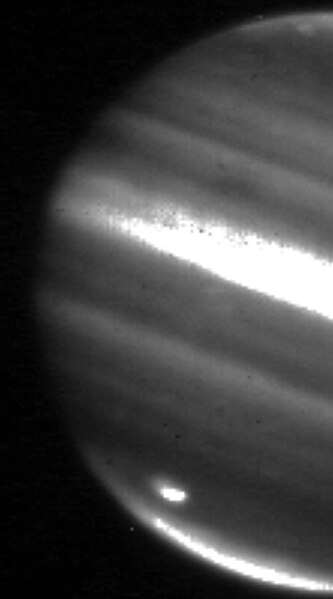NASA Infrared Telescope Facility
The NASA Infrared Telescope Facility is a 3-meter (9.8 ft) telescope optimized for use in infrared astronomy and located at the Mauna Kea Observatory in Hawaii. It was first built to support the Voyager missions and is now the US national facility for infrared astronomy, providing continued support to planetary, solar neighborhood, and deep space applications. The IRTF is operated by the University of Hawaii under a cooperative agreement with NASA. According to the IRTF's time allocation rules, at least 50% of the observing time is devoted to planetary science.
NASA Infrared Telescope Facility
Thermal image of Jupiter obtained by NASA Infrared Telescope Facility in 2007
This telescope view in heat-light wavelengths observered by IRTF, shows where the comet struck planet Jupiter. Such impacts are an area of study as NASA scientist try to determine the danger of such impacts with Earth
Asteroid collisions with Earth as visualized by the space Artist Don Davis
Infrared astronomy is a sub-discipline of astronomy which specializes in the observation and analysis of astronomical objects using infrared (IR) radiation. The wavelength of infrared light ranges from 0.75 to 300 micrometers, and falls in between visible radiation, which ranges from 380 to 750 nanometers, and submillimeter waves.
SOFIA is an infrared telescope in an aircraft, shown here in a 2009 test
High on the Chajnantor Plateau, the Atacama Large Millimeter Array provides an extraordinary place for infrared astronomy.
Hubble infrared view of the Tarantula Nebula.
Artist impression of galaxy W2246-0526, a single galaxy glowing in infrared light as intensely as 350 trillion Suns.








